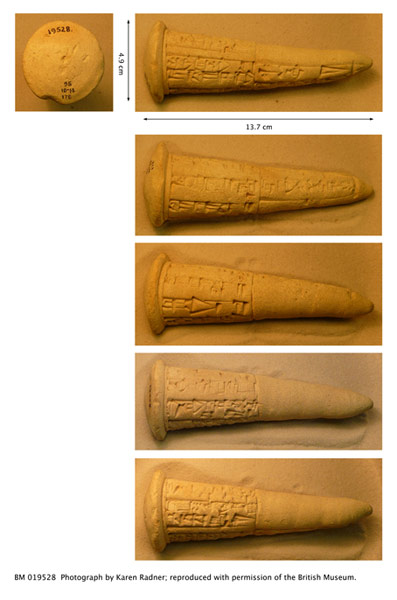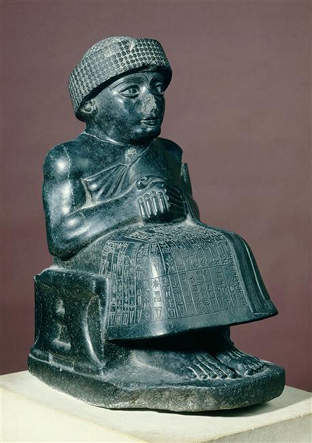BM 019528: royal inscription of Gudea, ruler of Lagaš, on a clay nail

BM 019528: royal inscription of Gudea, ruler of Lagaš, on a clay nail (Lagaš II period, c. 2150 BC). Photograph by Karen Radner; reproduced with permission of the British Museum. View large image.
Out of the chaos of the final days of the Akkadian empire – Who was king? Who was not king? as the Sumerian King List [http://etcsl.orinst.ox.ac.uk/cgi-bin/etcsl.cgi?text=t.2.1.1#] sardonically remarks – and the period of Gutian PGP domination, the old Sumerian cities arose resurgent. Among them in the 22nd century BC was Lagaš under the dynasty of king Gudea, whose face carved in shining black diorite stares back at us from the pages of almost every book on the history or art of Mesopotamia. Sumerian regained its place as language of state.

In this small statue of Gudea, the ruler sits with his hands clasped in prayer to his personal god Ningišzida. The head and the body were excavated separately but were reunited in the Louvre Museum (AO 3293, AO 4108). Photo © The Louvre Museum.
Clay "nails" such as this one record the building achievements of a city's ruler. They give his name and titles, the nature of the construction and the deity for whom the work was carried out. These nails were carefully placed in the walls of buildings, so that in years to come when a later ruler came to refurbish the temple, he would find them, read their text and learn (and presumably celebrate) the name of his pious forebear. Here Gudea commemorates his restoration of the Eninnu, the temple of Ningirsu, city-god of Lagaš.
The first column of text here starts near the head of the nail and wraps around the shaft until it meets itself. The double ruling marks the division between the beginning and end of the column. The second column starts adjacent to, and on a level with, the first. Later rulers would begin to write much lengthier inscriptions, and copy them on the enlarged head of the nail.
For more online photos, view the record for this tablet on the CDLI website.
A transliteration and translation of the text can be found in Edzard, RIME 3/1 (1997) 1.07.037, ex. 51 and online at the Cuneiform Digital Library Initiative.
Content last modified on 31 Mar 2025.
Jon Taylor
Jon Taylor, 'BM 019528: royal inscription of Gudea, ruler of Lagaš, on a clay nail', Knowledge and Power, Higher Education Academy, 2025 [http://oracc.museum.upenn.edu/saao/knpp/CuneiformRevealed/Tabletgallery/BM019528/]